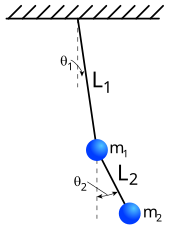双摆 是将一根单摆 连接在另一个单摆的尾部所构成的系统。双摆同时拥有着简单的构造和复杂的行为。高能量双摆的摆动轨迹表现出对于初始状态的极端敏感。两个初始状态差异极小的双摆在一段时间的运行后表现非常不同,是一种具有混沌 性质的简单动力系统 [ 1] [ 2]
将一根单摆连接在另一根的尾部,即为双摆。
可以考虑许多不同种类的双摆:二个摆的长度及重量可能相同,也可能不同。二个摆可能都是单摆,也有可能是复摆(compound pendulum),其运动可能限制在二维空间,也可以在三维空间内进行。在以下的分析中,二个摆的摆长l m
双摆 双摆的运动,依运动方程进行数值积分 所得 双摆的轨迹 复摆的质量假设是延著其长度均匀分布,则其复摆的质心 是在中点,复摆的臂对中点的转动惯量 为I = 1 / 12 ml 2
比较方便定义系统位形空间 的方式是用复摆臂和垂直线之间的夹角为广义座标 。角度名称为θ 1 θ 2 笛卡尔坐标系 的原点是在第一个摆(最上方摆)的固定点,则其第一个摆的质心在:
x
1
=
l
2
sin
θ
1
y
1
=
−
l
2
cos
θ
1
{\displaystyle {\begin{aligned}x_{1}&={\frac {l}{2}}\sin \theta _{1}\\y_{1}&=-{\frac {l}{2}}\cos \theta _{1}\end{aligned}}}
第二个摆的质心在:
x
2
=
l
(
sin
θ
1
+
1
2
sin
θ
2
)
y
2
=
−
l
(
cos
θ
1
+
1
2
cos
θ
2
)
{\displaystyle {\begin{aligned}x_{2}&=l\left(\sin \theta _{1}+{\tfrac {1}{2}}\sin \theta _{2}\right)\\y_{2}&=-l\left(\cos \theta _{1}+{\tfrac {1}{2}}\cos \theta _{2}\right)\end{aligned}}}
上述资讯已经可以建立拉格朗日量(Lagrangian)。
双摆系统的拉格朗日量 为
L
=
kinetic energy
−
potential energy
=
1
2
m
(
v
1
2
+
v
2
2
)
+
1
2
I
(
θ
˙
1
2
+
θ
˙
2
2
)
−
m
g
(
y
1
+
y
2
)
=
1
2
m
(
x
˙
1
2
+
y
˙
1
2
+
x
˙
2
2
+
y
˙
2
2
)
+
1
2
I
(
θ
˙
1
2
+
θ
˙
2
2
)
−
m
g
(
y
1
+
y
2
)
{\displaystyle {\begin{aligned}L&={\text{kinetic energy}}-{\text{potential energy}}\\&={\tfrac {1}{2}}m\left(v_{1}^{2}+v_{2}^{2}\right)+{\tfrac {1}{2}}I\left({{\dot {\theta }}_{1}}^{2}+{{\dot {\theta }}_{2}}^{2}\right)-mg\left(y_{1}+y_{2}\right)\\&={\tfrac {1}{2}}m\left({{\dot {x}}_{1}}^{2}+{{\dot {y}}_{1}}^{2}+{{\dot {x}}_{2}}^{2}+{{\dot {y}}_{2}}^{2}\right)+{\tfrac {1}{2}}I\left({{\dot {\theta }}_{1}}^{2}+{{\dot {\theta }}_{2}}^{2}\right)-mg\left(y_{1}+y_{2}\right)\end{aligned}}}
第一项是质心的平移动能 ,第二项是摆延著质心旋转的转动动能,最后一项是双摆在均匀重心场下的势能 。其点标示表示变数的时间导数 。
将以上的座标代入,重组后可得
L
=
1
6
m
l
2
(
θ
˙
2
2
+
4
θ
˙
1
2
+
3
θ
˙
1
θ
˙
2
cos
(
θ
1
−
θ
2
)
)
+
1
2
m
g
l
(
3
cos
θ
1
+
cos
θ
2
)
.
{\displaystyle L={\tfrac {1}{6}}ml^{2}\left({{\dot {\theta }}_{2}}^{2}+4{{\dot {\theta }}_{1}}^{2}+3{{\dot {\theta }}_{1}}{{\dot {\theta }}_{2}}\cos(\theta _{1}-\theta _{2})\right)+{\tfrac {1}{2}}mgl\left(3\cos \theta _{1}+\cos \theta _{2}\right).}
这里只有一个守恒量(能量),没有守恒的动量,二个广义的动量可以表示为
p
θ
1
=
∂
L
∂
θ
˙
1
=
1
6
m
l
2
(
8
θ
˙
1
+
3
θ
˙
2
cos
(
θ
1
−
θ
2
)
)
p
θ
2
=
∂
L
∂
θ
˙
2
=
1
6
m
l
2
(
2
θ
˙
2
+
3
θ
˙
1
cos
(
θ
1
−
θ
2
)
)
.
{\displaystyle {\begin{aligned}p_{\theta _{1}}&={\frac {\partial L}{\partial {{\dot {\theta }}_{1}}}}={\tfrac {1}{6}}ml^{2}\left(8{{\dot {\theta }}_{1}}+3{{\dot {\theta }}_{2}}\cos(\theta _{1}-\theta _{2})\right)\\p_{\theta _{2}}&={\frac {\partial L}{\partial {{\dot {\theta }}_{2}}}}={\tfrac {1}{6}}ml^{2}\left(2{{\dot {\theta }}_{2}}+3{{\dot {\theta }}_{1}}\cos(\theta _{1}-\theta _{2})\right).\end{aligned}}}
上式可以求得
θ
˙
1
=
6
m
l
2
2
p
θ
1
−
3
cos
(
θ
1
−
θ
2
)
p
θ
2
16
−
9
cos
2
(
θ
1
−
θ
2
)
θ
˙
2
=
6
m
l
2
8
p
θ
2
−
3
cos
(
θ
1
−
θ
2
)
p
θ
1
16
−
9
cos
2
(
θ
1
−
θ
2
)
.
{\displaystyle {\begin{aligned}{{\dot {\theta }}_{1}}&={\frac {6}{ml^{2}}}{\frac {2p_{\theta _{1}}-3\cos(\theta _{1}-\theta _{2})p_{\theta _{2}}}{16-9\cos ^{2}(\theta _{1}-\theta _{2})}}\\{{\dot {\theta }}_{2}}&={\frac {6}{ml^{2}}}{\frac {8p_{\theta _{2}}-3\cos(\theta _{1}-\theta _{2})p_{\theta _{1}}}{16-9\cos ^{2}(\theta _{1}-\theta _{2})}}.\end{aligned}}}
运动方程式为
p
˙
θ
1
=
∂
L
∂
θ
1
=
−
1
2
m
l
2
(
θ
˙
1
θ
˙
2
sin
(
θ
1
−
θ
2
)
+
3
g
l
sin
θ
1
)
p
˙
θ
2
=
∂
L
∂
θ
2
=
−
1
2
m
l
2
(
−
θ
˙
1
θ
˙
2
sin
(
θ
1
−
θ
2
)
+
g
l
sin
θ
2
)
.
{\displaystyle {\begin{aligned}{{\dot {p}}_{\theta _{1}}}&={\frac {\partial L}{\partial \theta _{1}}}=-{\tfrac {1}{2}}ml^{2}\left({{\dot {\theta }}_{1}}{{\dot {\theta }}_{2}}\sin(\theta _{1}-\theta _{2})+3{\frac {g}{l}}\sin \theta _{1}\right)\\{{\dot {p}}_{\theta _{2}}}&={\frac {\partial L}{\partial \theta _{2}}}=-{\tfrac {1}{2}}ml^{2}\left(-{{\dot {\theta }}_{1}}{{\dot {\theta }}_{2}}\sin(\theta _{1}-\theta _{2})+{\frac {g}{l}}\sin \theta _{2}\right).\end{aligned}}}
最后四个方程是有系统目前状态时,系统随时间演进的显式方程。不太可能再进一步求得方程的积分解析解,得到θ 1 θ 2 龙格-库塔法 或其他数值方式,可以进行数值积分 来求解。
复摆模拟示意图。
双摆不同初始条件下,翻倒时间的图 延时摄影拍摄的双摆轨迹 双摆的运动是混沌 运动,且对初始条件 非常敏感。右图是双摆在不同初始条件下,是否会翻倒(成为倒摆)的图。其θ 1 x θ 2 y
10√l g 100√l g 1000√l g 10000√l g 三个初始位置几乎相同的双摆,一段时间后轨迹的发散,表示系统的混沌特性 若在10000√l g
中心白色区域的边界可以依能量守恒推得,为以下的曲线:
3
cos
θ
1
+
cos
θ
2
=
2.
{\displaystyle 3\cos \theta _{1}+\cos \theta _{2}=2.}
因此若
3
cos
θ
1
+
cos
θ
2
>
2
,
{\displaystyle 3\cos \theta _{1}+\cos \theta _{2}>2,}
以能量的关系,双摆不可能翻倒。在此区域外,以能量来说,双摆有可能翻倒,但是否会翻倒本身是很复杂的问题。若双摆的末端是点质量 ,不是质量均匀分布的杆子,情形类似[ 3]
双摆没有自然共振频率,因此可用在大楼抗震设计的双摆系统
Meirovitch, Leonard. Elements of Vibration Analysis 2nd. McGraw-Hill Science/Engineering/Math. 1986. ISBN 0-07-041342-8 Eric W. Weisstein, Double pendulum (页面存档备份 ,存于互联网档案馆 )(contains details of the complicated equations involved) and "Double Pendulum (页面存档备份 ,存于互联网档案馆 )" by Rob Morris, Wolfram Demonstrations Project , 2007 (animations of those equations).
Peter Lynch , Double Pendulum (Java applet simulation.) Northwestern University, Double Pendulum (页面存档备份 ,存于互联网档案馆 )(Java applet simulation.)
Theoretical High-Energy Astrophysics Group at UBC, Double pendulum 